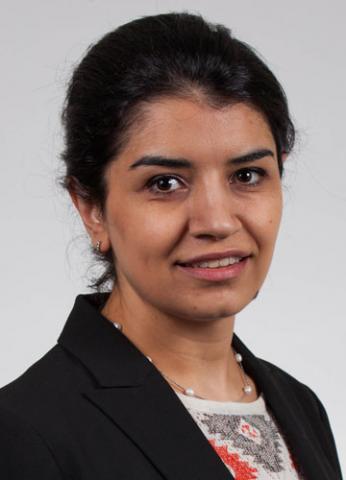Predicting Alzheimer's disease

Cancers are complex and hard to predict, but, having developed new models to predict lung cancer survival based on tumor heterogeneity, Ani Eloyan, assistant professor of biostatistics, is now tackling an even more complex and enigmatic organ—the human brain. Eloyan’s goal is to better predict the trajectory of disease for people with early-onset Alzheimer’s.
Alzheimer’s research has undergone a revolution in the past two decades. Post mortem analyses of the brains of Alzheimer’s patients have shown that they often feature unusual plaques of amyloid proteins, but these plaques were largely not detectable in CT scans of living brains. Advances in Positron Emission Tomography (PET) scan allowed researchers to image brains of living patients with unprecedented detail, even identifying plaques in patients without symptoms. Brain scans would “light up” where amyloid plaques were forming, says Eloyan. Trials of pharmaceutical interventions to slow or prevent the formation of plaques were greeted with tremendous optimism, but ultimately yielded little clinical benefit. Alzheimer’s researchers now suggest that rather than thinking of Alzheimer’s as a single disease, we should think of it as a set of diseases, with multiple pathways to similar clinical outcomes. As Eloyan puts it, “Not just ‘Alzheimer’s or not’ but what type of Alzheimer’s is this—what clinical function is most affected?”
With this more nuanced and complex understanding of the disease, Eloyan is working to build models that correlate patterns revealed by brain scans with specific patterns of impairment. Her work involves deep collaboration with physicians, radiologists, and neurologists. “I think the best research comes when we work with collaborators who understand more about the biology.”
“Ten years ago, a lot of the Alzheimer’s studies were very small. So you could have a finding and then it wouldn’t hold in the future.” The Longitudinal Early-Onset Alzheimer’s Disease Study (LEADS) is funded by the National Institute on Aging in the National Institutes of Health, and aims to follow 500 cognitively impaired participants and 100 cognitively normal participants at multiple sites around the country. The Alzheimer’s Disease Neuroimaging Initiative—another multisite study—has been running for longer than LEADS and Eloyan says has collected thousands of images. “There’s a lot of data, and so hopefully some of what we are finding will hold up better.”
For the moment, however, Eloyan is wary of discussing how her work might translate into treatments for Alzheimer’s, but her work is paving the way to better understand new treatments and assess how well they work with much greater precision. “We’re not comparing therapies,” she says. “We are trying to identify what are the main markers we should look at in clinical trials. If you want to show that a certain treatment is helpful, then you have to show effects on this marker, that it’s changing in this way over the course of treatment.”
The research is also limited by the expense and accessibility of PET scans. So far, Eloyan’s data has been drawn entirely from American study participants, something that Eloyan, who grew up in Armenia, is acutely aware of. “I just found out four months ago that they acquired the first PET scanner in the country. Granted it’s a small country. But until four months ago, anybody that wanted to get a PET scan would have to travel internationally to do it.” International research is also limited by clinical challenges. “If you run the same test, but in a different language, things may be different. This is another aspect of biostatistics—How can we deal with this? What kind of data can we collect that would be universal, and what are the data that would have to be analyzed differently or incorporated differently because of language and differences across cultures. There’s a lot that goes into these discussions.”
Read the full Continuum Magazine article on Brown's School of Public Health website.



